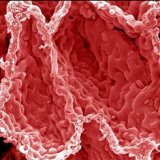Chronical bronchitis
 Chronic bronchitis is commonly referred to as diffuse bronchial inflammation, which is not due to local or frontal lung involvement. It manifests itself, as a rule, by coughing. With such bronchitis, the duration of productive cough( with the exception of other diseases) is at least 3 months for the year and appears 3 years in a row. With this disease there is a pronounced symptomatology.
Chronic bronchitis is commonly referred to as diffuse bronchial inflammation, which is not due to local or frontal lung involvement. It manifests itself, as a rule, by coughing. With such bronchitis, the duration of productive cough( with the exception of other diseases) is at least 3 months for the year and appears 3 years in a row. With this disease there is a pronounced symptomatology.
Symptomatology
- presence in the bronchial mucosa diffuse inflammation;
- restructuring of the epithelial structures of the mucosa;
- hypersecretion and viscosity increase of secretory masses;
- impaired bronchial cleansing function;
- a persistent or episodic cough with phlegm, not caused by other diseases.
features primary and secondary chronic bronchitis
- called primary chronic bronchitis as a disease, not caused by another disease, or bronchopulmonary diseases of other organs. With such chronic bronchitis, the bronchial tree has a pronounced diffuse lesion.
- The secondary is caused by chronic inflammatory diseases of the nasal adnexal and sinus;Chronic pulmonary diseases, pulmonary tuberculosis;Heart diseases, kidney failure, etc. As a rule, secondary bronchitis manifests itself locally( diffuse - less often).
Chronic bronchitis is considered the most common lesion of the bronchopulmonary system. Depending on the nature of the disease, the nature of pathological processes and clinical picture includes such forms of the disease:
main forms of HB
- simple( non-obstructive( CNB) is characterized by lesions of medium and large and bronchi favorable course Its main manifestation is considered permanent or occasional, and cough with.mokrotnyh masses. A unexpressed symptoms of obstruction can only occur at the phase of exacerbation or at later stages.
- for obstructive( COB) characteristic already glubSclerotic and degenerative-inflammatory changes already in the distal parts of the airways. The clinical features of this form, in most cases, are unfavorable and characterized by a prolonged cough, an actively increasing dyspnea, a decrease in the capacity for physical exertion, and sometimes signs of partial inflammation of the bronchi
The main distinguishing featureCOB is a lesion of the respiratory parts of the lung, manifested by respiratory failure, progressing in parallel with the increase inFoam obstruction.
Classification by severity
- Easy( FEV1 more than 70%);
- average( FEV1 from 50 to 69%);
- severe( FEV1 less than 50% of the norm).
Disease Causes of chronic bronchitis is caused primarily bronchial irritation lengthy process various kinds of factors( smoking, contaminated with smoke, dust, chemical substances air), respiratory infections( Pfeiffer coli, respiratory viruses, pneumococci).Sometimes it can occur with alpha1-antitrypsin insufficiency, cystic fibrosis. Contributing factors are the chronic inflammatory and suppurative processes in the lungs, TTP, reduced body resistance, hereditary tendency to diseases TTP.
Pathological features and pathogenesis of
Hyperfunction and hypertrophy of bronchial glands are manifested, mucus secretion is increased, serous secretion is reduced, the secretion composition is changed( the level of acid mucopolysaccharides increases, which increases the viscosity of sputum).In such a situation, the ciliary epithelium does not update the secretory layer and cleans the bronchial tree and cleanses the bronchi in this state only when coughing. A ciliary epithelium lends itself to dystrophy or atrophy. The same glandular apparatus is also subject to the same degeneration, which produces antibacterial protectors. Therefore, there is a progression of bronchogenic infection.
In the development of the disease, oedemas, spasms, fibrous changes in bronchial walls with stenosis of their lumen are of great importance. A obstruction of the small bronchi promotes overgrowth of the alveoli, which leads to a decrease in the elasticity of their walls and the appearance of often ventilated and absolutely non-ventilated zones.
Because the blood passing through such alveoli is not completely enriched with oxygen, arterial hypoxemia arises that promotes spasmodic arterioles in the lungs and increases pulmonary arterial resistance. Consequently, pre-capillary pulmonary hypertension develops.
In the large bronchi can develop a superficial infiltration. And in the small and medium, in the bronchioles - deep, even with erosion, sometimes the development of meso - and panbronchitis. On the remission phase there is a decrease in inflammation, in general, a decrease in the production of exudate, proliferation of tissues and epithelium. The final phase of this process in the bronchi is sclerosis of the walls, atrophy of muscles, elastic fibers, glands, cartilage. There may be an irreversible narrowing of the lumen of the bronchus or its expansion with bronchiectasis.
Clinical characteristics of
The onset of the inflammatory process is slow. The first symptom is a morning cough with abundant sputum. But gradually it manifests itself at any time, often increasing with the inhalation of raw, cold or dry air. And the amount of sputum is increased. It will already be mucopurulent or purulent. Progresses and dyspnea.
During the course of the XB disease, 4 stages are distinguished:
- catarrhal;
- purulent;
- is obstructive;
- is purulent-obstructive.
The third stage is characterized by bronchial asthma and emphysema, and the fourth one, respectively, with purulent complications.
Diagnosis is performed with fibrrobronchoscopy, when the endobronchial symptoms of the inflammatory process and its degree of severity are visually assessed( only to subsegmental bronchi).With the help of bronchoscopy, mucosal biopsy and histological methods are used to clarify the character of its morphological changes, tracheobronchial hypotonic dyskinesia and static retraction, which can become complications of chronic bronchitis and even one of the causes of obstruction, are also revealed. But with such bronchitis the main pathological changes appear in the small bronchi. For this, bronchodilator and radiography are used in the diagnosis of the disease.
Diagnosis
Chronic bronchitis should be differentiated from tuberculosis, bronchial asthma and lung cancer. If from bronchial asthma HB is distinguished by the absence of attacks of suffocation( with obstructive bronchitis signs are regular cough and shortness of breath).
Treatment of
Treated with ambulatory care. To speed up the process of sputum discharge, expectorant actions of reflex( alteic root, infusion of thermopsis, coltsfoot, plantain), cistern derivatives and mucolytic drugs are prescribed. With the help of proteolytic enzymes, the viscosity of the sputum masses is weakened( in our time they are rarely used).Preference today is given to cetylcysteine, which has the ability to effectively dilute sputum, even purulent. It is also considered expedient to use mucoregulators( bromhexyl or ambroxol), which improve the drainage of the bronchi.
But with the appearance of symptoms of obstruction or are already prescribed and bronchodilators - holinoblokatory or beta-adrenomimetiki, preparations of theophylline rather long-acting. In the case of purulent sputum, symptoms of intoxication and leukocytosis, increased ESR use antimicrobial therapy with the courses necessary to suppress the progressiveness of the infection( 7-14 days).



